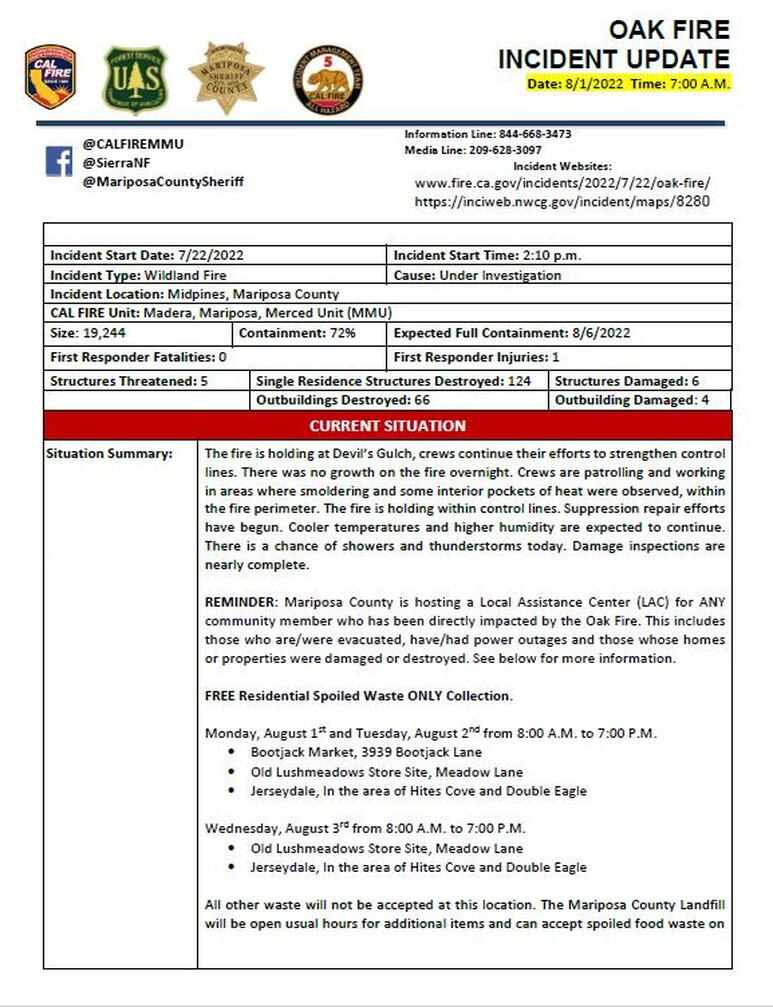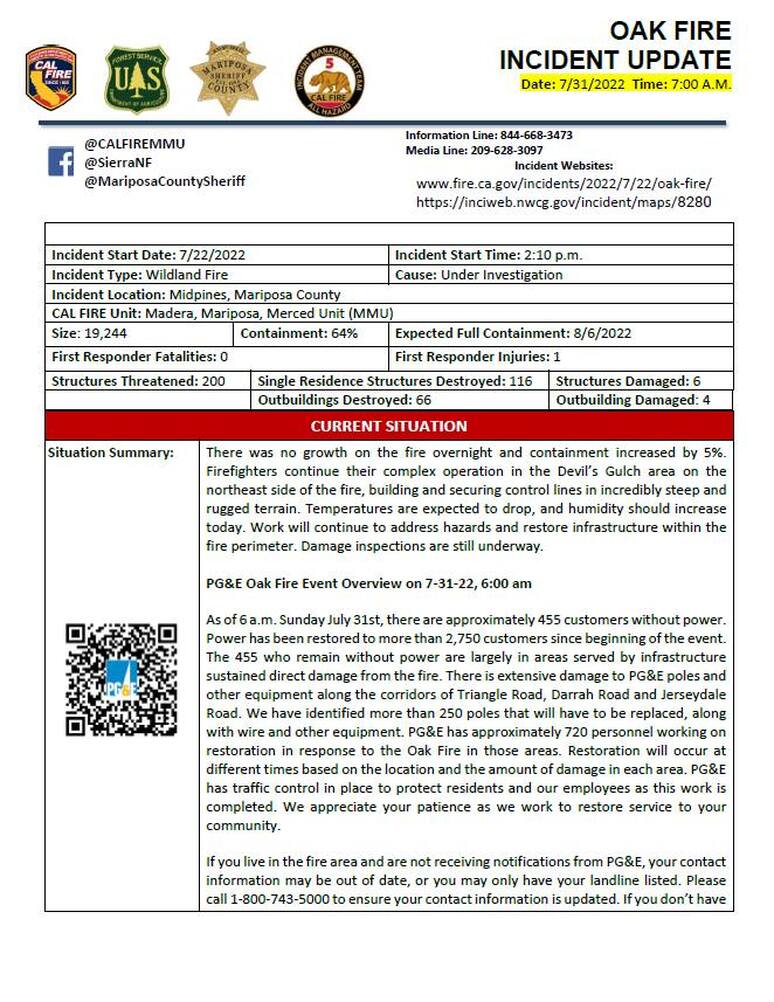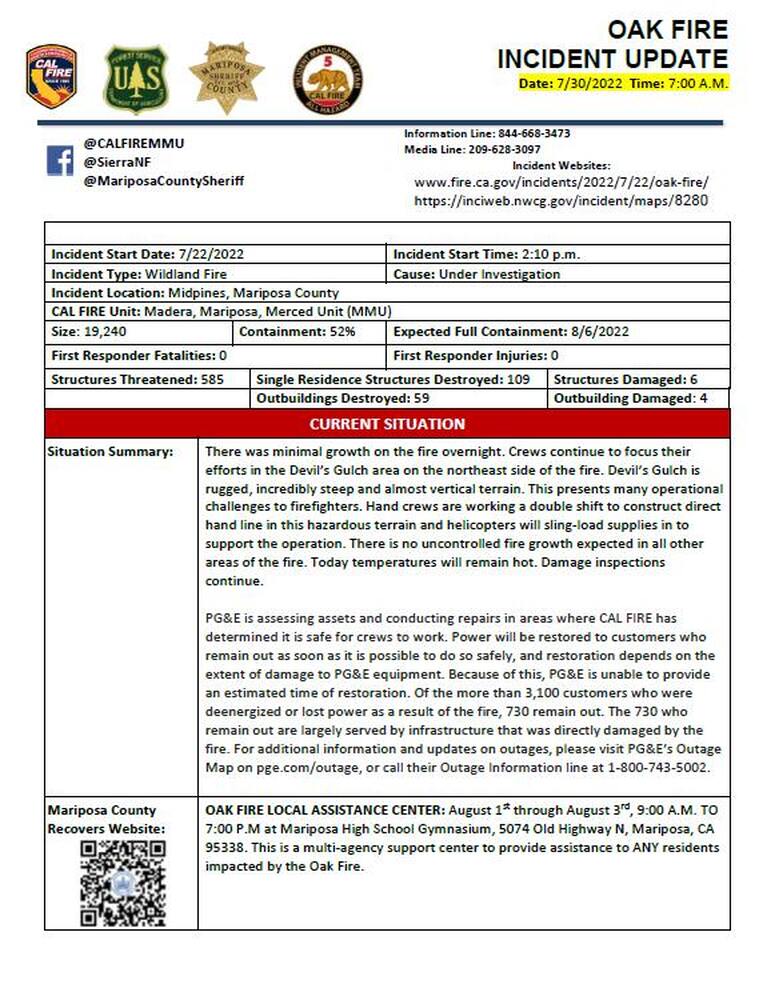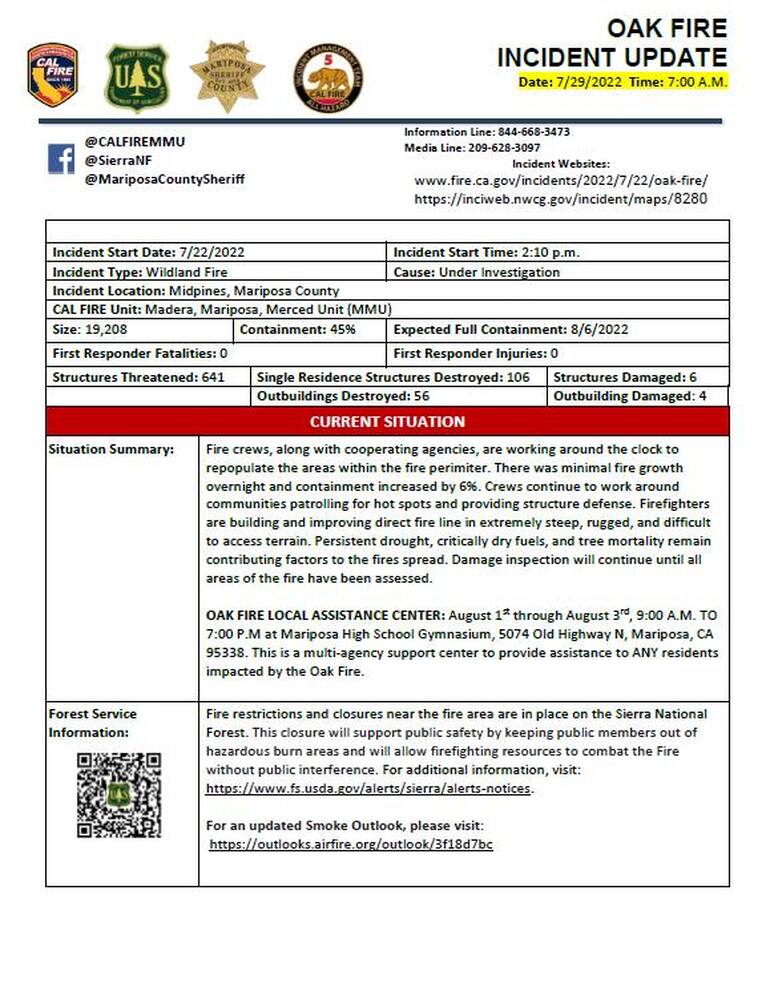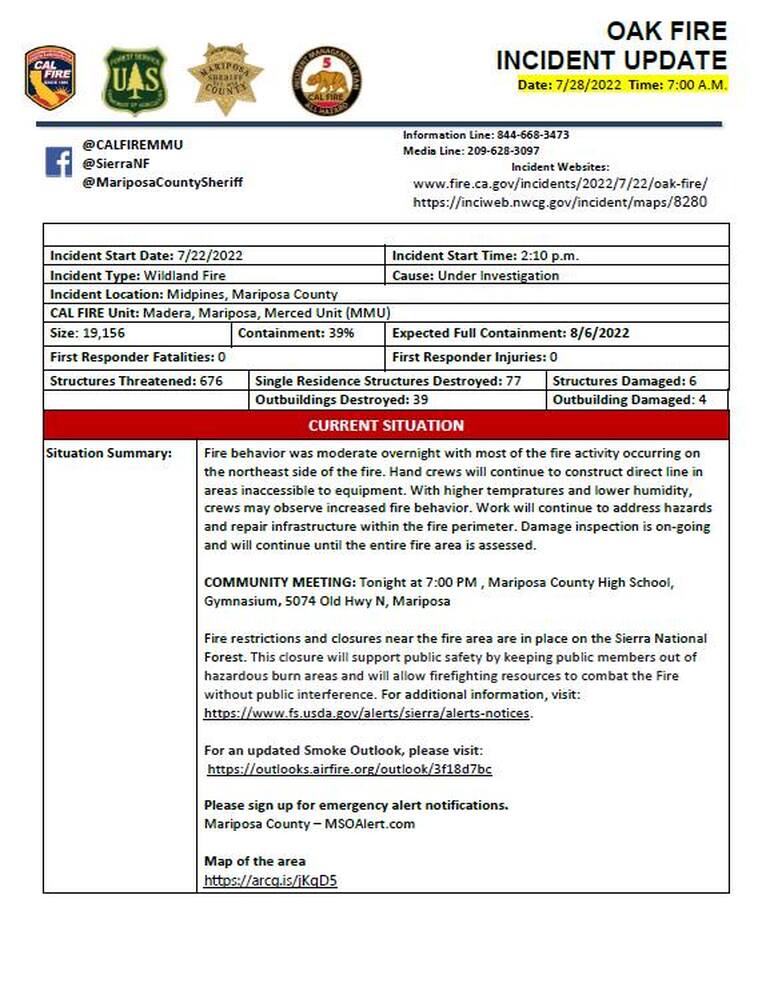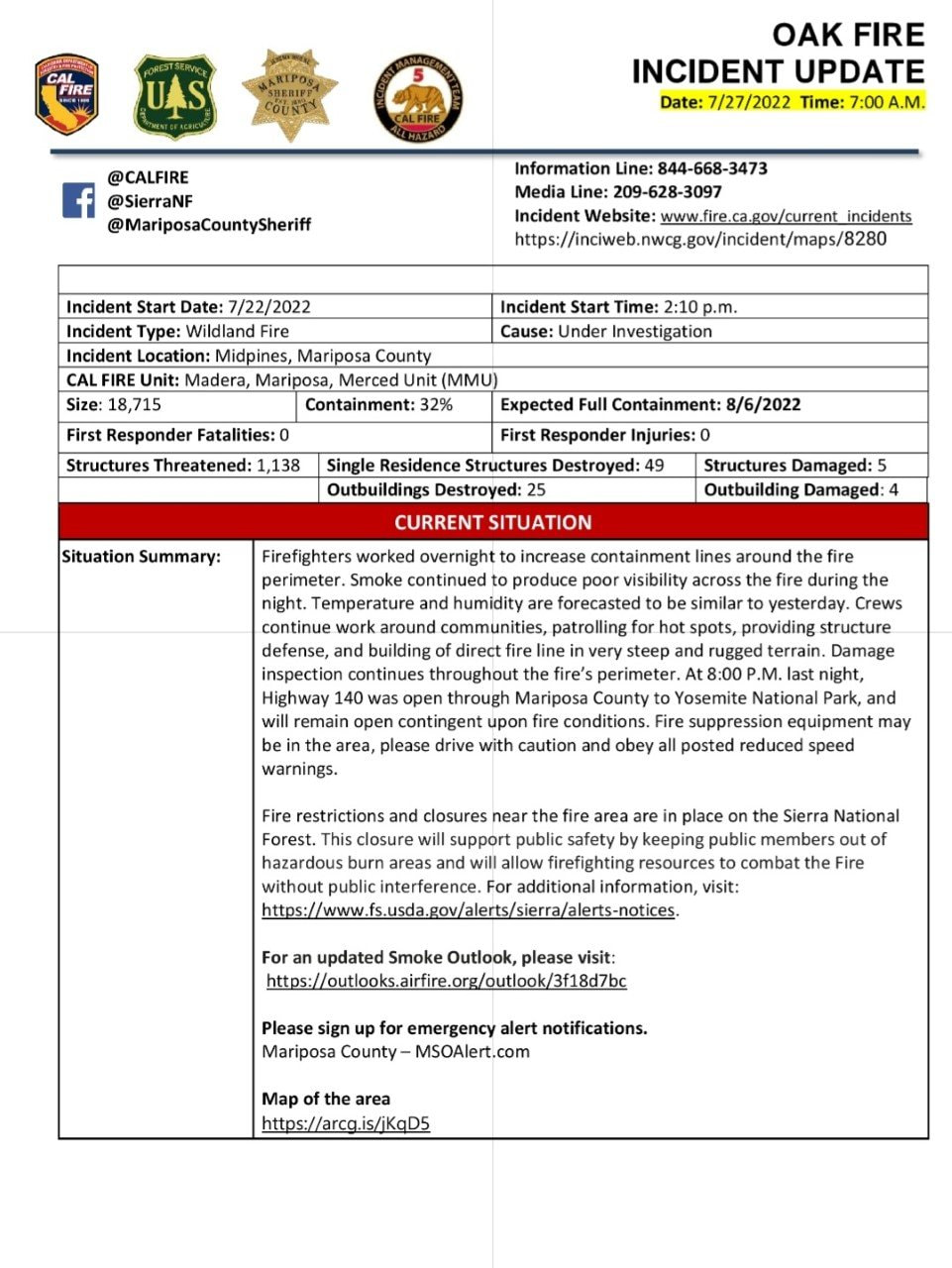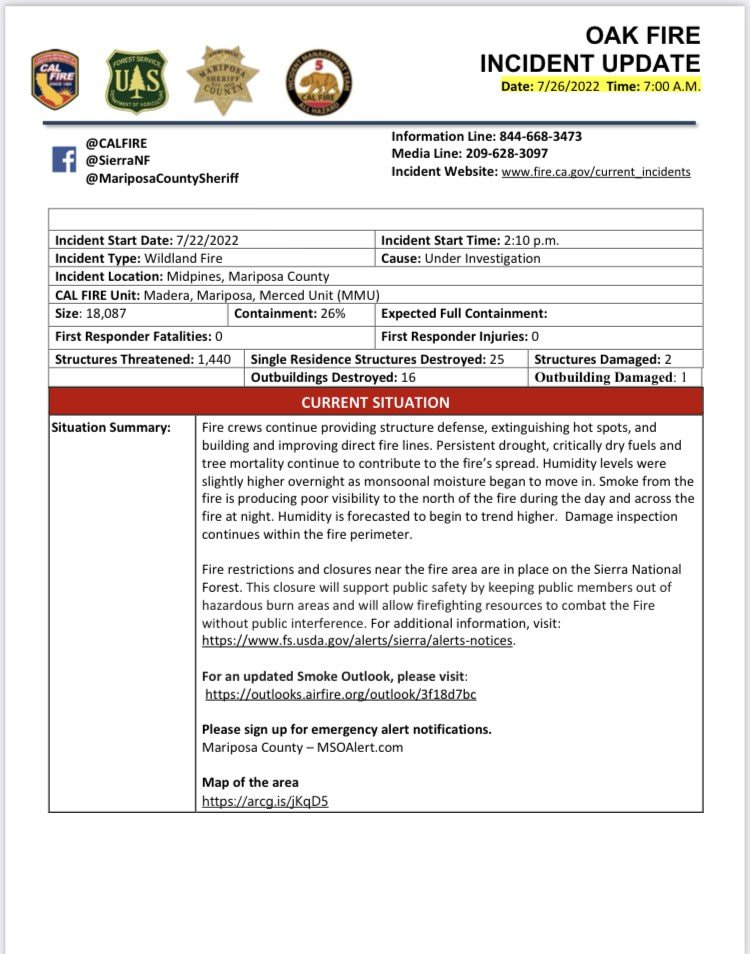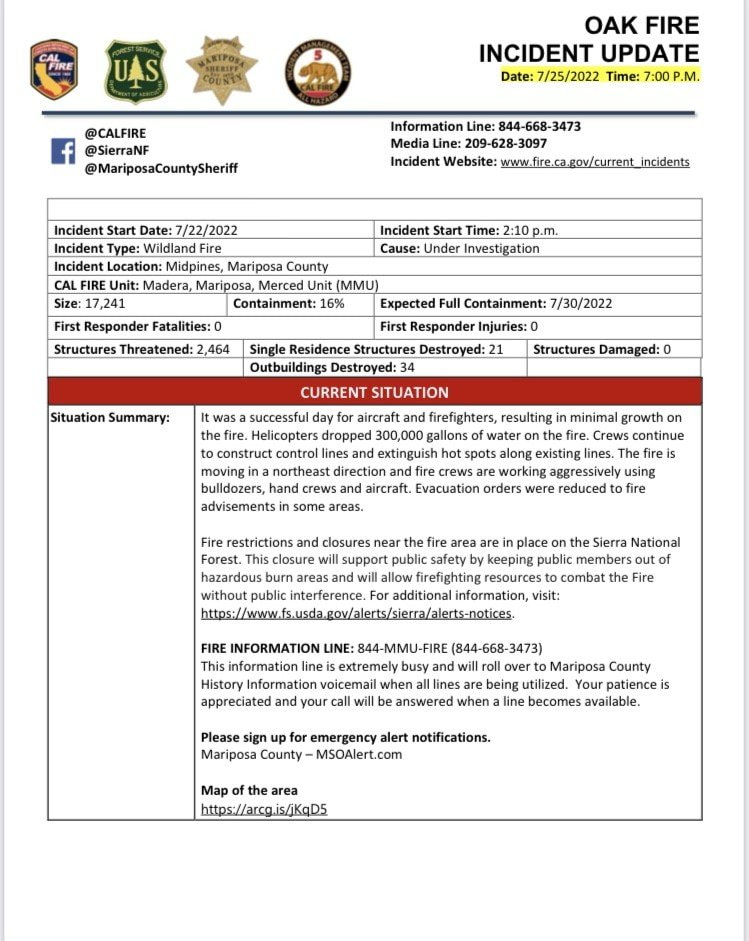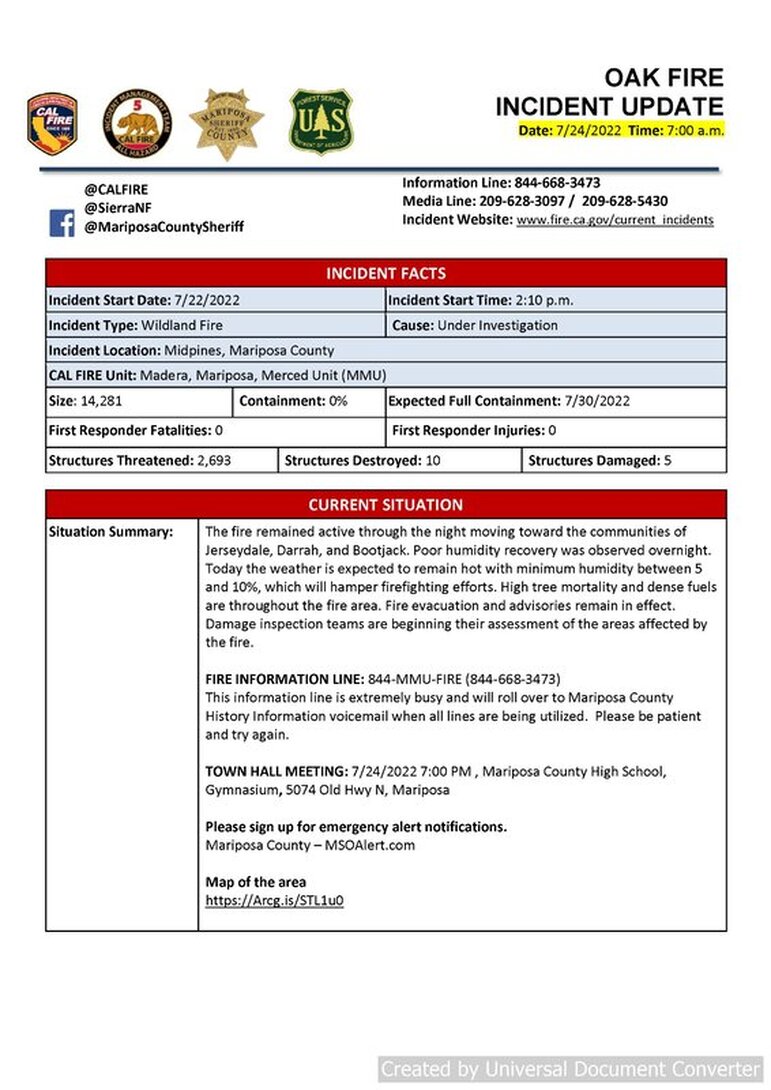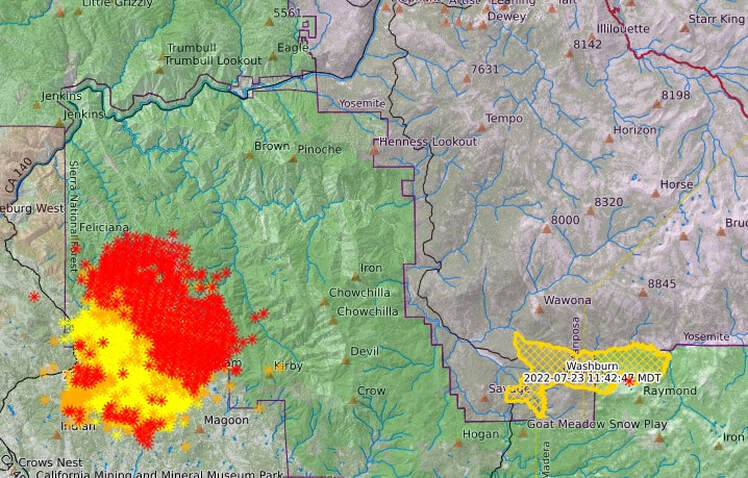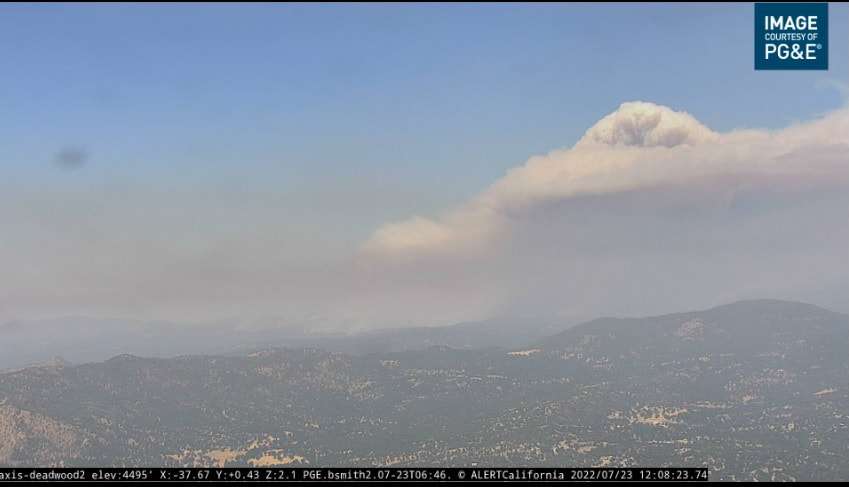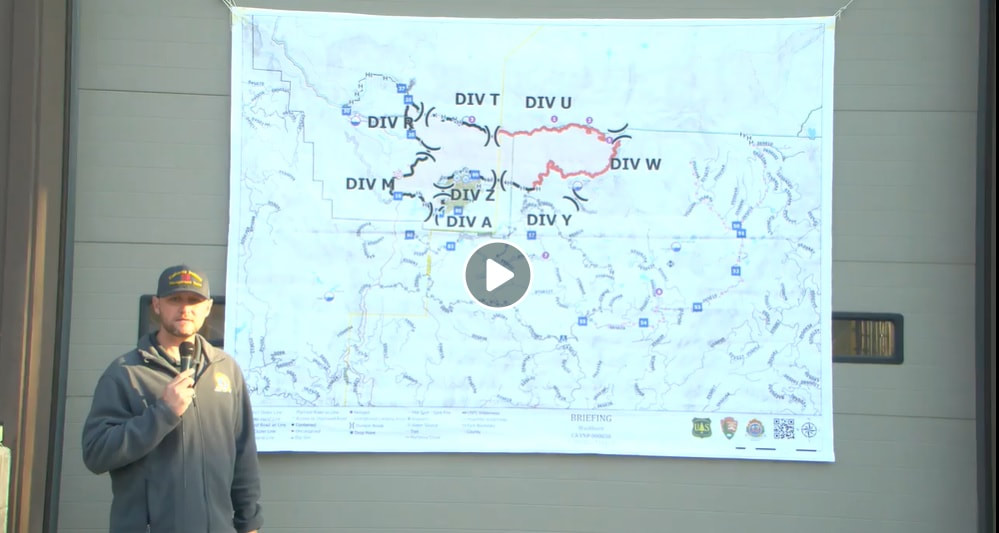WawonaNews.com - August 2022
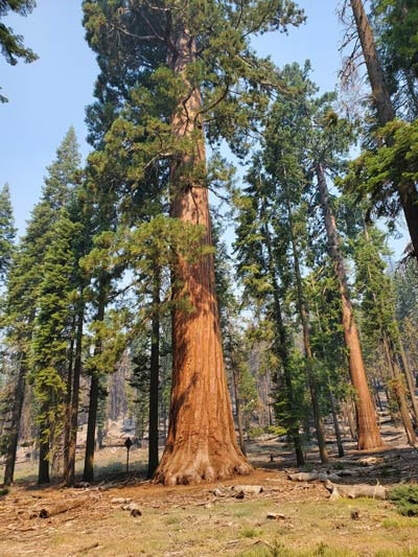
Mariposa Grove of Giant Sequoias will Reopen on Wednesday, August 3, at 8:00 A.M.
Sierra Sun Times- August 1, 2022 - Yosemite National Park Officials report the Mariposa Grove of Giant Sequoias will reopen on Wednesday, August 3, at 8:00 A.M. The Mariposa Grove shuttle will be operating.
Some areas remain closed:
The Washburn Trail (between the Mariposa Grove Welcome Plaza and the Arrival Area).
The western portion of the Perimeter Trail (from the Galen Clark Tree to near the Grizzly Giant Loop Trail).
The trail from the Mariposa Grove toward Wawona
Please stay on trails: hazards may exist off trail.
Firefighters will continue patrolling the area until the fire is declared out.
Source: NPS
Sierra Sun Times- August 1, 2022 - Yosemite National Park Officials report the Mariposa Grove of Giant Sequoias will reopen on Wednesday, August 3, at 8:00 A.M. The Mariposa Grove shuttle will be operating.
Some areas remain closed:
The Washburn Trail (between the Mariposa Grove Welcome Plaza and the Arrival Area).
The western portion of the Perimeter Trail (from the Galen Clark Tree to near the Grizzly Giant Loop Trail).
The trail from the Mariposa Grove toward Wawona
Please stay on trails: hazards may exist off trail.
Firefighters will continue patrolling the area until the fire is declared out.
Source: NPS
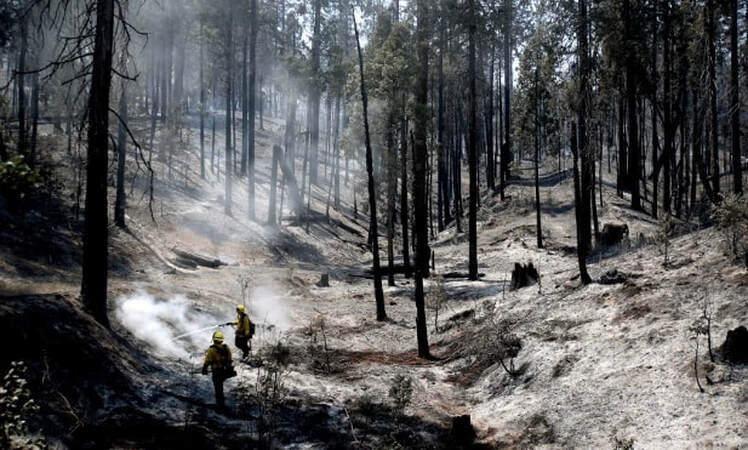 Firefighters douse hot spots in a scorched and ash-filled area of forest that burned recently in near Mariposa. (Luis Sinco / Los Angeles Times)
Firefighters douse hot spots in a scorched and ash-filled area of forest that burned recently in near Mariposa. (Luis Sinco / Los Angeles Times)
Two California fires in the Sierra Nevada have very different outcomes. Why?
BY ALEX WIGGLESWORTH STAFF WRITER
JULY 30, 2022 5 AM PT
The two fires started just 17 miles apart in the rugged terrain of California’s western Sierra Nevada — but their outcomes couldn’t have been more different.
The Washburn fire, which ignited July 7 along a forested trail in Yosemite National Park, was nearly contained, with no damage to structures or to the famed Mariposa Grove of giant sequoias.
But the Oak fire, which sparked almost two weeks later in the foothills near Midpines, confounded firefighters as it exploded to four times the size of Washburn and forced thousands to flee as it destroyed at least 106 homes. At times, the wildfire’s smoke plume could be seen from space.
Why was one fire so much more destructive?
Experts attribute the difference to variations in weather, vegetation and topography. The management history of each landscape also played a role: Yosemite boasts decades of active stewardship, including prescribed burns, while areas outside the park bear a legacy of industrial logging and fire suppression.
The Washburn fire started along a trail on the edge of the Mariposa Grove, just downhill from the road used by shuttle buses to ferry tourists from a parking lot.
Since vegetation along the trail was dense, and flames travel more quickly uphill, officials worried that the fire would grow hotter, gain speed and slam into the sequoia grove, said Yosemite Fire Chief Dan Buckley. That could result in a high-severity crown fire similar to those that have destroyed an estimated 20% of the world’s population of the ancient giants since 2020, he said.
But luck was on the side of the fire officials: Two Yosemite battalion chiefs were teaching a chainsaw class to a sizable contingent of firefighters in the nearby Wawona area and were able to quickly respond, along with a water tender, two engines and the park’s water-dropping helicopter.
As the engines sprayed burning sequoias, park rangers enlisted civilian tour bus drivers to evacuate more than 450 visitors from the grove.
“They actually had to drive through flames on both sides of the road when they were taking these people out,” Buckley said. The rescue was completed in about 90 minutes, allowing firefighters to focus on the flames, he said.
When the fire spread to the Mariposa Grove, it met a prescribed burn area that crews had treated in 2017, reducing the amount of brush and duff, or decaying vegetation, that would otherwise have helped the flames travel faster. Also, the winds picked up slightly and pushed flames away from the heart of the grove and downhill toward Wawona.
Those factors allowed firefighters to build a flanking line and steer flames around the grove, said Mike Theune, fire information officer for the National Park Service’s Pacific West region.
When the Oak fire started the afternoon of July 22 in a patch of oak grassland, temperatures reached the 90s, and humidity was in the single digits. It took just 16 hours for the blaze to leapfrog the Washburn fire in size as it burned through steeper, less accessible, more populated terrain.
“The Oak fire started much lower in elevation. It’s much drier,” said Adrienne Freeman, fire information officer with the U.S. Forest Service. “And the key thing is it’s a different fuel type. There’s a heavy brush component.”
Parched brush and grass helped spread flames into stands of dense timber littered with conifers that had been killed by drought and bark beetles, Freeman said.
California’s drought, which has been intensified by climate change, has killed upward of 100 million trees in the central and southern Sierra, said Scott Stephens, professor of fire science at UC Berkeley. Dead and fallen trees that are overgrown by shrubs burn extremely effectively. When enough ignite at once, they draw in oxygen that increases the burning rate, Stephens said. Researchers call this a “mass fire,” a term that was coined to describe the effects of incendiary bombing attacks in World War II, he said.
“It actually creates a localized low-pressure system,” he said.
Stephens was part of a team of researchers that documented this behavior in the 2020 Creek fire for a study published in May in Forest Ecology and Management. They found dead biomass, followed by live tree density, to be the two most important variables when it comes to predicting fire severity.
“Someone showed me a picture of the Oak fire, and it had a pyrocumulus cloud created above it at least 20,000 feet in height,” Stephens said. “That gets me wondering if we’re seeing similar behavior, at least in parts of that fire.”
The density of the vegetation is tied to the history of the land, which was logged starting in the mid-1800s.
“The Oak fire is burning in areas that have had big trees removed and lots of moderate and small trees brought in, and that homogeneity is going to make it worse,” Stephens said.
Also, Mariposa County is the ancestral home of the Southern Sierra Miwuk, who regularly set controlled fires — that is, until white settlers criminalized cultural burning. Its absence has upended the balance of the ecosystems, the Miwuk and fire scientists say. The area where the Oak fire began had not burned in nearly 100 years, according to fire history maps.
“This landscape here specifically needs healthy fire,” said Clay River, director of the Miwumati Healing Center, which serves as the hub for Miwuk health and social services.
After the Miwuk were violently evicted from Yosemite Valley for the formation of the national park, they were forcibly relocated to the foothills along what is now Highway 140, where the fire began, River said. Many are now watching their homes and cultural sites burn, she said.
California’s drought, which has been intensified by climate change, has killed upward of 100 million trees in the central and southern Sierra, said Scott Stephens, professor of fire science at UC Berkeley. Dead and fallen trees that are overgrown by shrubs burn extremely effectively. When enough ignite at once, they draw in oxygen that increases the burning rate, Stephens said. Researchers call this a “mass fire,” a term that was coined to describe the effects of incendiary bombing attacks in World War II, he said.
“It actually creates a localized low-pressure system,” he said.
Stephens was part of a team of researchers that documented this behavior in the 2020 Creek fire for a study published in May in Forest Ecology and Management. They found dead biomass, followed by live tree density, to be the two most important variables when it comes to predicting fire severity.
“Someone showed me a picture of the Oak fire, and it had a pyrocumulus cloud created above it at least 20,000 feet in height,” Stephens said. “That gets me wondering if we’re seeing similar behavior, at least in parts of that fire.”
The density of the vegetation is tied to the history of the land, which was logged starting in the mid-1800s.
“The Oak fire is burning in areas that have had big trees removed and lots of moderate and small trees brought in, and that homogeneity is going to make it worse,” Stephens said.
Also, Mariposa County is the ancestral home of the Southern Sierra Miwuk, who regularly set controlled fires — that is, until white settlers criminalized cultural burning. Its absence has upended the balance of the ecosystems, the Miwuk and fire scientists say. The area where the Oak fire began had not burned in nearly 100 years, according to fire history maps.
“This landscape here specifically needs healthy fire,” said Clay River, director of the Miwumati Healing Center, which serves as the hub for Miwuk health and social services.
After the Miwuk were violently evicted from Yosemite Valley for the formation of the national park, they were forcibly relocated to the foothills along what is now Highway 140, where the fire began, River said. Many are now watching their homes and cultural sites burn, she said.
Still, in the days that followed the Washburn fire’s initial advance, officials worried that it might circle back around and threaten the grove. The area contained dead trees and brush from a January 2020 wind event that blew down 28 mature giant sequoias and thousands of other trees.
But firefighters reported a major victory about three days into the fight, when they were able to hold the fire at Wawona Road to the west.
Officials credited a 2020 biomass removal project led by Garrett Dickman, a park forest ecologist, and the Mariposa County Resource Conservation District, with funding from a California Climate Investments grant. Teams removed close to 9,000 tons of vegetation along three miles of the road between Wawona and the Mariposa Grove, which they hope to follow with a series of prescribed fires, Dickman said.
When flames reached the site of the project, they dimmed and in some places extinguished, Dickman said. Firefighters were able to stand on the road and douse hot spots, freeing up personnel to aggressively protect Wawona and the grove.
Some models indicated that had the fire launched embers over the road, it could have burned into Wawona, Fish Camp, Ponderosa Basin or Lushmeadows, Dickman said.
“It would have been a very, very, very different fire,” he said.
BY ALEX WIGGLESWORTH STAFF WRITER
JULY 30, 2022 5 AM PT
The two fires started just 17 miles apart in the rugged terrain of California’s western Sierra Nevada — but their outcomes couldn’t have been more different.
The Washburn fire, which ignited July 7 along a forested trail in Yosemite National Park, was nearly contained, with no damage to structures or to the famed Mariposa Grove of giant sequoias.
But the Oak fire, which sparked almost two weeks later in the foothills near Midpines, confounded firefighters as it exploded to four times the size of Washburn and forced thousands to flee as it destroyed at least 106 homes. At times, the wildfire’s smoke plume could be seen from space.
Why was one fire so much more destructive?
Experts attribute the difference to variations in weather, vegetation and topography. The management history of each landscape also played a role: Yosemite boasts decades of active stewardship, including prescribed burns, while areas outside the park bear a legacy of industrial logging and fire suppression.
The Washburn fire started along a trail on the edge of the Mariposa Grove, just downhill from the road used by shuttle buses to ferry tourists from a parking lot.
Since vegetation along the trail was dense, and flames travel more quickly uphill, officials worried that the fire would grow hotter, gain speed and slam into the sequoia grove, said Yosemite Fire Chief Dan Buckley. That could result in a high-severity crown fire similar to those that have destroyed an estimated 20% of the world’s population of the ancient giants since 2020, he said.
But luck was on the side of the fire officials: Two Yosemite battalion chiefs were teaching a chainsaw class to a sizable contingent of firefighters in the nearby Wawona area and were able to quickly respond, along with a water tender, two engines and the park’s water-dropping helicopter.
As the engines sprayed burning sequoias, park rangers enlisted civilian tour bus drivers to evacuate more than 450 visitors from the grove.
“They actually had to drive through flames on both sides of the road when they were taking these people out,” Buckley said. The rescue was completed in about 90 minutes, allowing firefighters to focus on the flames, he said.
When the fire spread to the Mariposa Grove, it met a prescribed burn area that crews had treated in 2017, reducing the amount of brush and duff, or decaying vegetation, that would otherwise have helped the flames travel faster. Also, the winds picked up slightly and pushed flames away from the heart of the grove and downhill toward Wawona.
Those factors allowed firefighters to build a flanking line and steer flames around the grove, said Mike Theune, fire information officer for the National Park Service’s Pacific West region.
When the Oak fire started the afternoon of July 22 in a patch of oak grassland, temperatures reached the 90s, and humidity was in the single digits. It took just 16 hours for the blaze to leapfrog the Washburn fire in size as it burned through steeper, less accessible, more populated terrain.
“The Oak fire started much lower in elevation. It’s much drier,” said Adrienne Freeman, fire information officer with the U.S. Forest Service. “And the key thing is it’s a different fuel type. There’s a heavy brush component.”
Parched brush and grass helped spread flames into stands of dense timber littered with conifers that had been killed by drought and bark beetles, Freeman said.
California’s drought, which has been intensified by climate change, has killed upward of 100 million trees in the central and southern Sierra, said Scott Stephens, professor of fire science at UC Berkeley. Dead and fallen trees that are overgrown by shrubs burn extremely effectively. When enough ignite at once, they draw in oxygen that increases the burning rate, Stephens said. Researchers call this a “mass fire,” a term that was coined to describe the effects of incendiary bombing attacks in World War II, he said.
“It actually creates a localized low-pressure system,” he said.
Stephens was part of a team of researchers that documented this behavior in the 2020 Creek fire for a study published in May in Forest Ecology and Management. They found dead biomass, followed by live tree density, to be the two most important variables when it comes to predicting fire severity.
“Someone showed me a picture of the Oak fire, and it had a pyrocumulus cloud created above it at least 20,000 feet in height,” Stephens said. “That gets me wondering if we’re seeing similar behavior, at least in parts of that fire.”
The density of the vegetation is tied to the history of the land, which was logged starting in the mid-1800s.
“The Oak fire is burning in areas that have had big trees removed and lots of moderate and small trees brought in, and that homogeneity is going to make it worse,” Stephens said.
Also, Mariposa County is the ancestral home of the Southern Sierra Miwuk, who regularly set controlled fires — that is, until white settlers criminalized cultural burning. Its absence has upended the balance of the ecosystems, the Miwuk and fire scientists say. The area where the Oak fire began had not burned in nearly 100 years, according to fire history maps.
“This landscape here specifically needs healthy fire,” said Clay River, director of the Miwumati Healing Center, which serves as the hub for Miwuk health and social services.
After the Miwuk were violently evicted from Yosemite Valley for the formation of the national park, they were forcibly relocated to the foothills along what is now Highway 140, where the fire began, River said. Many are now watching their homes and cultural sites burn, she said.
California’s drought, which has been intensified by climate change, has killed upward of 100 million trees in the central and southern Sierra, said Scott Stephens, professor of fire science at UC Berkeley. Dead and fallen trees that are overgrown by shrubs burn extremely effectively. When enough ignite at once, they draw in oxygen that increases the burning rate, Stephens said. Researchers call this a “mass fire,” a term that was coined to describe the effects of incendiary bombing attacks in World War II, he said.
“It actually creates a localized low-pressure system,” he said.
Stephens was part of a team of researchers that documented this behavior in the 2020 Creek fire for a study published in May in Forest Ecology and Management. They found dead biomass, followed by live tree density, to be the two most important variables when it comes to predicting fire severity.
“Someone showed me a picture of the Oak fire, and it had a pyrocumulus cloud created above it at least 20,000 feet in height,” Stephens said. “That gets me wondering if we’re seeing similar behavior, at least in parts of that fire.”
The density of the vegetation is tied to the history of the land, which was logged starting in the mid-1800s.
“The Oak fire is burning in areas that have had big trees removed and lots of moderate and small trees brought in, and that homogeneity is going to make it worse,” Stephens said.
Also, Mariposa County is the ancestral home of the Southern Sierra Miwuk, who regularly set controlled fires — that is, until white settlers criminalized cultural burning. Its absence has upended the balance of the ecosystems, the Miwuk and fire scientists say. The area where the Oak fire began had not burned in nearly 100 years, according to fire history maps.
“This landscape here specifically needs healthy fire,” said Clay River, director of the Miwumati Healing Center, which serves as the hub for Miwuk health and social services.
After the Miwuk were violently evicted from Yosemite Valley for the formation of the national park, they were forcibly relocated to the foothills along what is now Highway 140, where the fire began, River said. Many are now watching their homes and cultural sites burn, she said.
Still, in the days that followed the Washburn fire’s initial advance, officials worried that it might circle back around and threaten the grove. The area contained dead trees and brush from a January 2020 wind event that blew down 28 mature giant sequoias and thousands of other trees.
But firefighters reported a major victory about three days into the fight, when they were able to hold the fire at Wawona Road to the west.
Officials credited a 2020 biomass removal project led by Garrett Dickman, a park forest ecologist, and the Mariposa County Resource Conservation District, with funding from a California Climate Investments grant. Teams removed close to 9,000 tons of vegetation along three miles of the road between Wawona and the Mariposa Grove, which they hope to follow with a series of prescribed fires, Dickman said.
When flames reached the site of the project, they dimmed and in some places extinguished, Dickman said. Firefighters were able to stand on the road and douse hot spots, freeing up personnel to aggressively protect Wawona and the grove.
Some models indicated that had the fire launched embers over the road, it could have burned into Wawona, Fish Camp, Ponderosa Basin or Lushmeadows, Dickman said.
“It would have been a very, very, very different fire,” he said.
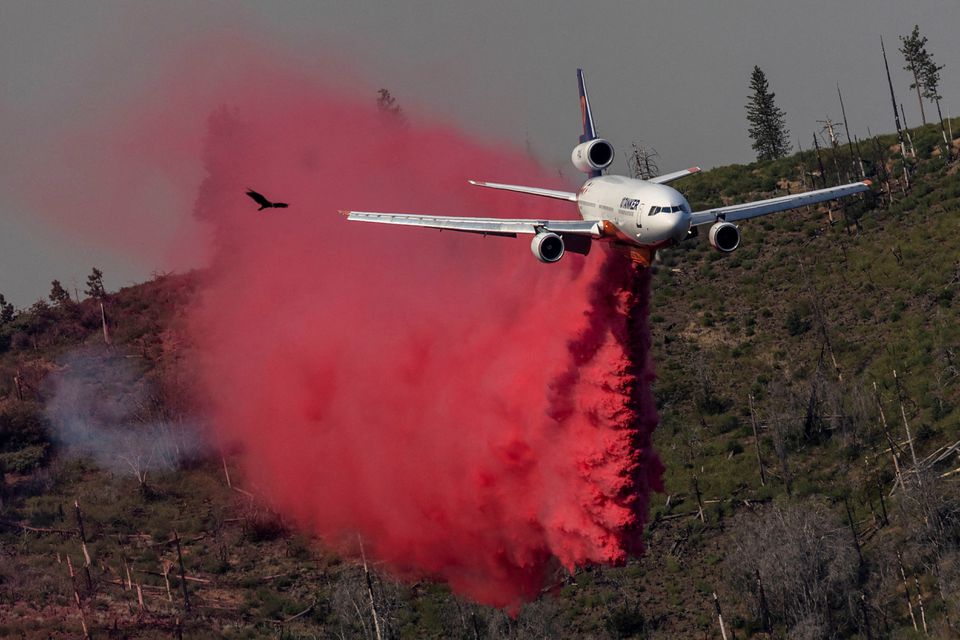 A bird flies as a firefighting aircraft drops flame retardant on a hillside to control the Oak Fire while burning near Darrah in Mariposa County, California, U.S., July 24, 2022. REUTERS/Carlos Barria
A bird flies as a firefighting aircraft drops flame retardant on a hillside to control the Oak Fire while burning near Darrah in Mariposa County, California, U.S., July 24, 2022. REUTERS/Carlos Barria
Firefighters start to contain raging California wildfire near Yosemite
By Sharon Bernstein
MARIPOSA, Calif., July 25 (Reuters) - Firefighters on Monday finally started to control California's largest wildfire so far this year, halting its eastward expansion toward nearby Yosemite National Park while thousands of people remained under evacuation orders.
The Oak Fire had expanded rapidly after it began on Friday, overwhelming the initial deployment of firefighters, as extremely hot and dry weather fueled its galloping pace through dry forest and underbrush.
But Monday was "a successful day for aircraft and firefighters" as helicopters dropped 300,000 gallons (1.4 million liters) of water on the fire, the California Department of Forestry and Fire Protection (Cal Fire) said in a Monday night update.
The fire grew to 17,241 acres (6,977 hectares) by Monday night, about a 3% increase from Monday morning, Cal Fire said, more than half the size of San Francisco.
It was 16% contained, up from 10% contained on Monday morning, and 3,700 people had been evacuated.
The report contrasted with comments on Sunday from several Cal Fire officials who said the fire initially behaved unlike any other they had seen and defied their best efforts at containment, with burning embers sparking smaller fires up to two miles in front of the main conflagration.
The absence of other major fires in the region enabled Cal Fire to concentrate 2,500 firefighters on the blaze, and the lack of wind allowed for the continuous use of aircraft to drop water and fire retardant, officials said.
By Sharon Bernstein
MARIPOSA, Calif., July 25 (Reuters) - Firefighters on Monday finally started to control California's largest wildfire so far this year, halting its eastward expansion toward nearby Yosemite National Park while thousands of people remained under evacuation orders.
The Oak Fire had expanded rapidly after it began on Friday, overwhelming the initial deployment of firefighters, as extremely hot and dry weather fueled its galloping pace through dry forest and underbrush.
But Monday was "a successful day for aircraft and firefighters" as helicopters dropped 300,000 gallons (1.4 million liters) of water on the fire, the California Department of Forestry and Fire Protection (Cal Fire) said in a Monday night update.
The fire grew to 17,241 acres (6,977 hectares) by Monday night, about a 3% increase from Monday morning, Cal Fire said, more than half the size of San Francisco.
It was 16% contained, up from 10% contained on Monday morning, and 3,700 people had been evacuated.
The report contrasted with comments on Sunday from several Cal Fire officials who said the fire initially behaved unlike any other they had seen and defied their best efforts at containment, with burning embers sparking smaller fires up to two miles in front of the main conflagration.
The absence of other major fires in the region enabled Cal Fire to concentrate 2,500 firefighters on the blaze, and the lack of wind allowed for the continuous use of aircraft to drop water and fire retardant, officials said.
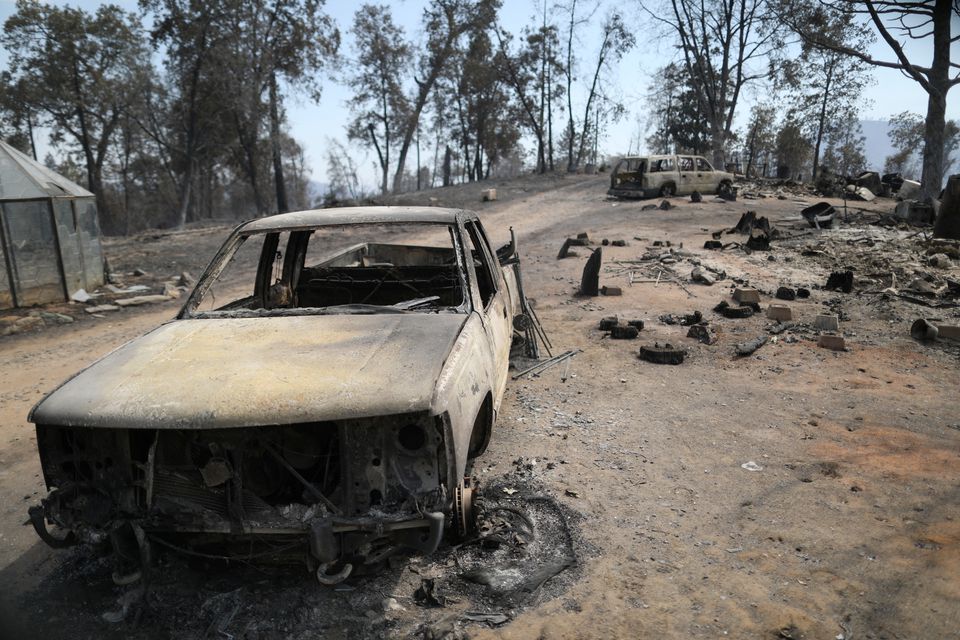 Cars sit burned as the Oak Fire burns near Jerseydale in Mariposa County, California, U.S. July 25, 2022. REUTERS/David Swanson
Cars sit burned as the Oak Fire burns near Jerseydale in Mariposa County, California, U.S. July 25, 2022. REUTERS/David Swanson
"It was a perfect storm of a good kind," said Hector Vasquez, a Cal Fire spokesperson, at the command post in Mariposa, California, about 150 miles inland from San Francisco.
The northward direction of the fire was taking it into the Sierra National Forest but no longer in the direction of Yosemite, some 10 miles away. A grove of Yosemite's giant, ancient sequoia trees did come under threat from another wildfire weeks ago.
Temperatures in the area soared to 97 degrees Fahrenheit (36 Celsius) while scant chances for thunderstorms faded. The National Weather Service forecast 100-degree weather for much of the week.
More than two decades of drought and rising temperatures have conspired to make California more vulnerable than ever to wildfires, with the two most devastating years on record coming in 2020 and 2021, when more than 6.8 million acres burned, an area greater than the size of Rwanda.
The northward direction of the fire was taking it into the Sierra National Forest but no longer in the direction of Yosemite, some 10 miles away. A grove of Yosemite's giant, ancient sequoia trees did come under threat from another wildfire weeks ago.
Temperatures in the area soared to 97 degrees Fahrenheit (36 Celsius) while scant chances for thunderstorms faded. The National Weather Service forecast 100-degree weather for much of the week.
More than two decades of drought and rising temperatures have conspired to make California more vulnerable than ever to wildfires, with the two most devastating years on record coming in 2020 and 2021, when more than 6.8 million acres burned, an area greater than the size of Rwanda.
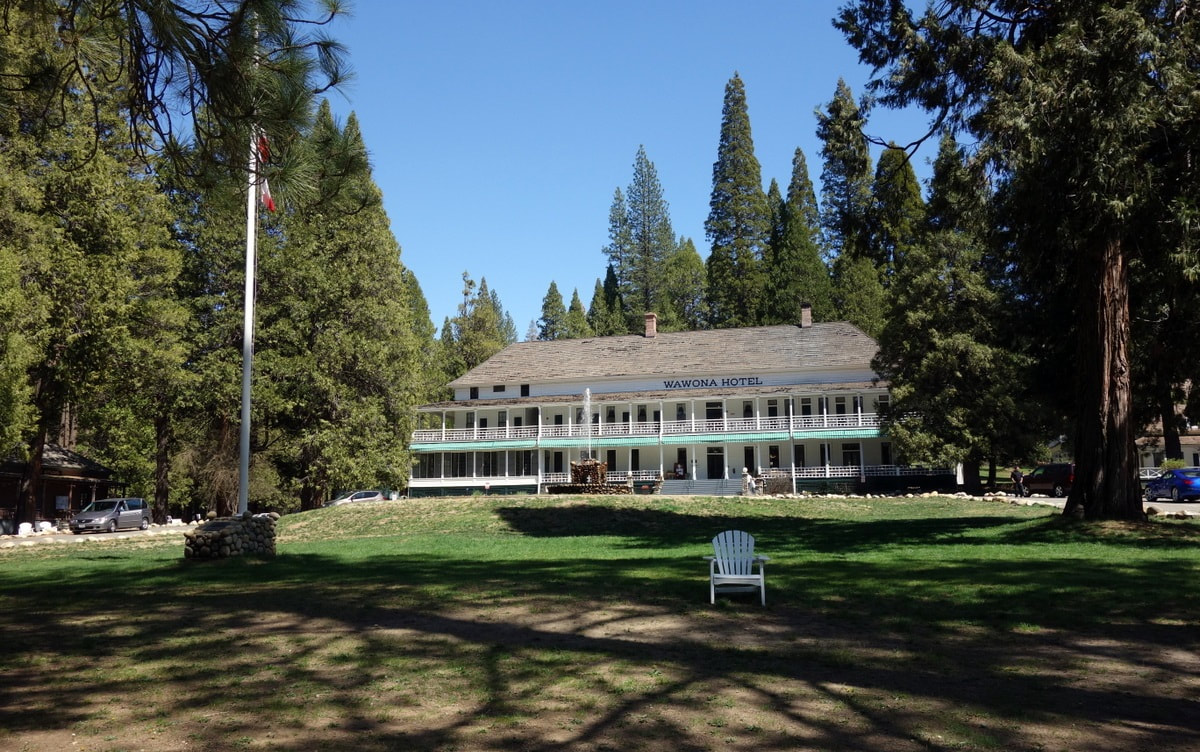
Wawona Reopening To Everybody July 28
The community of Wawona (including the Wawona Hotel and vacation rentals) will reopen to the public on Thursday, July 28, at noon.
The wilderness area north of Wawona opens today, Monday, July 25, and the fire advisory has been lifted for the wilderness area.
The Mariposa Grove of Giant Sequoias and the Wawona Campground remain closed due to the Washburn fire. You can find Washburn fire updates at https://inciweb.nwcg.gov/incident/8209/.
All other areas of Yosemite are open, although a reservation is required to drive into the park if arriving between 6 am and 4 pm: https://go.nps.gov/reserve.
The Oak fire is currently burning west of Yosemite in the Mariposa/Midpines area. This fire has caused the closure of Highway 140 west of Mariposa and has resulted in poor air quality. You can check on air quality at https://fire.airnow.gov/ and get Oak fire updates at https://www.fire.ca.gov/incidents/2022/7/22/oak-fire/.
Chad Andrews
Wawona District Ranger
Yosemite National Park
(W) 209-375-9520
(C) 209-742-8269
The community of Wawona (including the Wawona Hotel and vacation rentals) will reopen to the public on Thursday, July 28, at noon.
The wilderness area north of Wawona opens today, Monday, July 25, and the fire advisory has been lifted for the wilderness area.
The Mariposa Grove of Giant Sequoias and the Wawona Campground remain closed due to the Washburn fire. You can find Washburn fire updates at https://inciweb.nwcg.gov/incident/8209/.
All other areas of Yosemite are open, although a reservation is required to drive into the park if arriving between 6 am and 4 pm: https://go.nps.gov/reserve.
The Oak fire is currently burning west of Yosemite in the Mariposa/Midpines area. This fire has caused the closure of Highway 140 west of Mariposa and has resulted in poor air quality. You can check on air quality at https://fire.airnow.gov/ and get Oak fire updates at https://www.fire.ca.gov/incidents/2022/7/22/oak-fire/.
Chad Andrews
Wawona District Ranger
Yosemite National Park
(W) 209-375-9520
(C) 209-742-8269
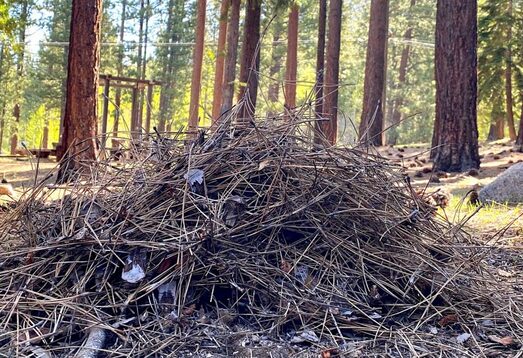
Pine Needle Pickup and Log Removal Update
Hi all. Things have changed a bit with the Oak Fire and I wanted to give you a current update. Our contractor is working with most of his crew fighting the Oak Fire and may be there for some time. In the meantime, I am working with YNP to look for alternatives to remove pine needle piles separate from the fuels reduction and biomass portions of the work. I will let you know as soon as I have something pinned down, but as I hope you can appreciate, things are a bit unpredictable right now. We will pick up all the piles and get the rest of the work done as conditions allow. I apologize that we have so many outside circumstances affecting our schedule!
Thank you,
Melinda
Hi all. Things have changed a bit with the Oak Fire and I wanted to give you a current update. Our contractor is working with most of his crew fighting the Oak Fire and may be there for some time. In the meantime, I am working with YNP to look for alternatives to remove pine needle piles separate from the fuels reduction and biomass portions of the work. I will let you know as soon as I have something pinned down, but as I hope you can appreciate, things are a bit unpredictable right now. We will pick up all the piles and get the rest of the work done as conditions allow. I apologize that we have so many outside circumstances affecting our schedule!
Thank you,
Melinda
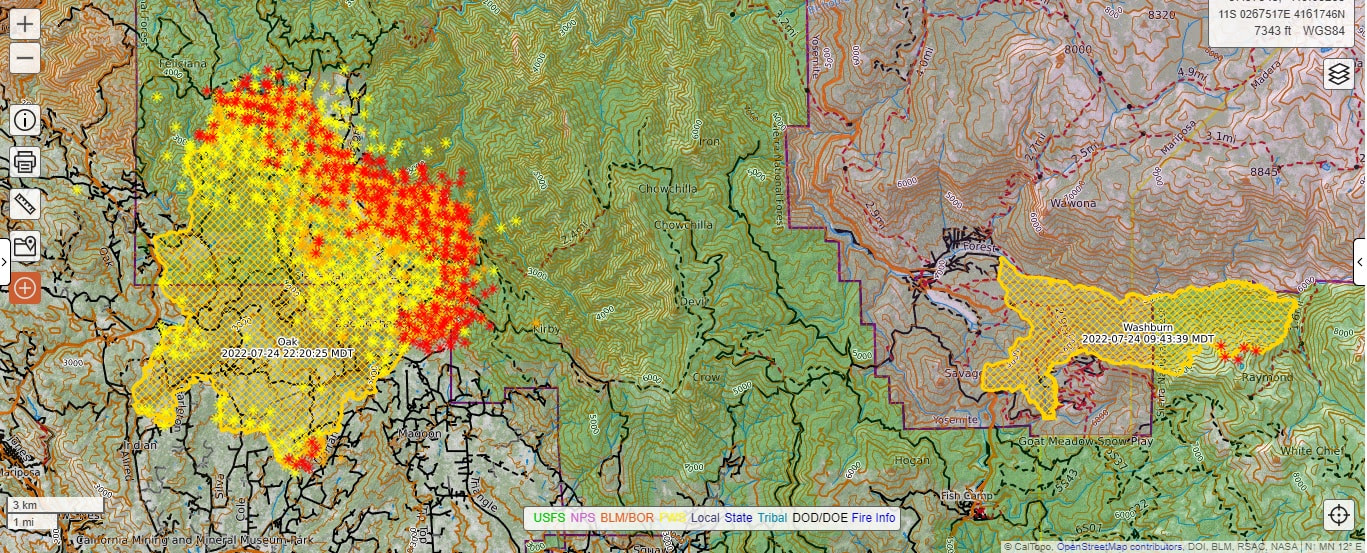
Oak Fire: 10% Contained, 16,781 Acres
Cal Fire 7/25 - Fire activity was not as extreme as it has been in previous days. Firefighters made good headway today. On the north side, the fire passed Sweetwater Ridge and made a hard push towards the community of Mariposa Pines. Three strike teams were able to hold the fire at Bear Clover Lane, protecting Mariposa Pines. Crews worked to hold the line at Footman Ridge, on the northeast side of the fire. Line was completed around the community of Lushmeadows. Fire line is holding on the east side. Crews are working to complete and hold line on the south side. The fire continues to be fuel and terrain driven. The fire perimeter is moving into the Ferguson Fire burn scar in the northeast side. Damage inspection teams began surveying the affected areas today.
Cal Fire 7/25 - Fire activity was not as extreme as it has been in previous days. Firefighters made good headway today. On the north side, the fire passed Sweetwater Ridge and made a hard push towards the community of Mariposa Pines. Three strike teams were able to hold the fire at Bear Clover Lane, protecting Mariposa Pines. Crews worked to hold the line at Footman Ridge, on the northeast side of the fire. Line was completed around the community of Lushmeadows. Fire line is holding on the east side. Crews are working to complete and hold line on the south side. The fire continues to be fuel and terrain driven. The fire perimeter is moving into the Ferguson Fire burn scar in the northeast side. Damage inspection teams began surveying the affected areas today.
Washburn Fire: 87% Contained, 4866 Acres
Brief Summary Of Oak Fire Community Meeting
By Watch Duty -Jul 24th at 8:45 PM
Few notes from community meeting: good progress on the western side of fire along Hwy 140 from Carstens Rd down to Triangle Rd, direct line in there. Tactical patrol & structure defense continues throughout incident. They're also feeling much more confident about the southern side of fire. The fire remains established in Snow Creek. The fire is being held @ Bear Clover Ln. Intense firefight in the Footman Ridge area. Damage assessment teams arrived yesterday & were out in the field today, hoping to have some data available tomorrow.
Note: Presenter also referred to dozer lines and teams of firefighters stationed along an eastern side ridge hoping to hold the fire's progress in that direction.
By Watch Duty -Jul 24th at 8:45 PM
Few notes from community meeting: good progress on the western side of fire along Hwy 140 from Carstens Rd down to Triangle Rd, direct line in there. Tactical patrol & structure defense continues throughout incident. They're also feeling much more confident about the southern side of fire. The fire remains established in Snow Creek. The fire is being held @ Bear Clover Ln. Intense firefight in the Footman Ridge area. Damage assessment teams arrived yesterday & were out in the field today, hoping to have some data available tomorrow.
Note: Presenter also referred to dozer lines and teams of firefighters stationed along an eastern side ridge hoping to hold the fire's progress in that direction.
Video starts at minute 5:15. NOTE: Unlike the updates we had been getting daily from Matt Ahearn, this is mostly a meeting with and for the new fire personnel.
Oak Fire 7/24, 7:30 AM: 0% Containment, 14,281 Acres
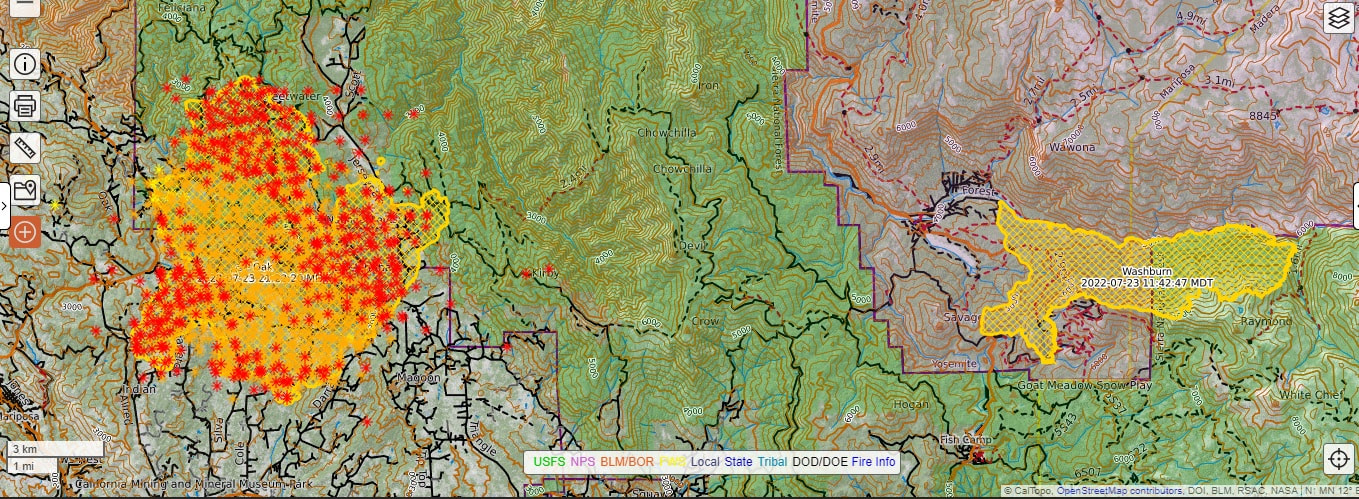
Oak Fire 7/23, 10:15 PM: 0% Containment, 12,597 Acres
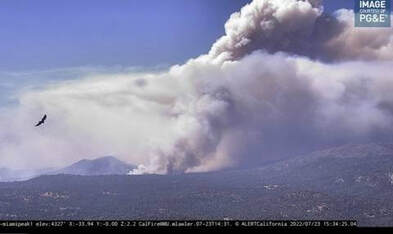
Oak Fire 7/23, 4:45 PM: 0% Containment, 11,500 Acres
Watch Duty. 7/23, 4:11 PM
Jerseydale Rd, just North of Triangle Rd is "completely compromised", per radio traffic. Significant activity off the spot fire that started around Pinecrest Drive.
Jul 23rd at 3:40 PM
The fire has reportedly jumped Jerseydale road to the east near Wild Dove lane. Extreme fire activity still occurring with long range spotting.
Watch Duty. 7/23, 4:11 PM
Jerseydale Rd, just North of Triangle Rd is "completely compromised", per radio traffic. Significant activity off the spot fire that started around Pinecrest Drive.
Jul 23rd at 3:40 PM
The fire has reportedly jumped Jerseydale road to the east near Wild Dove lane. Extreme fire activity still occurring with long range spotting.
Oak Fire 7/23, 12 Noon: 9,100 Acres, 0% Containment
Jul 23rd at 12:17 - Watch Duty
Fire is making a significant run to the East and North, West of Jerseydale Rd with spotting across dozer lines. Pulling ground resources back.
Fire is making a significant run to the East and North, West of Jerseydale Rd with spotting across dozer lines. Pulling ground resources back.
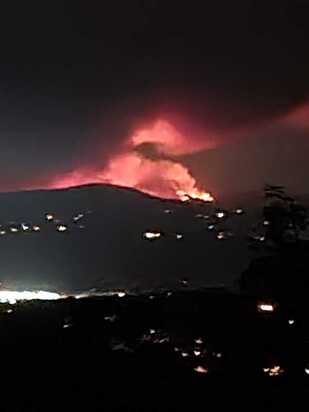
Oak Fire Update, 5:00 AM, July 23rd: 6,555 Acres, 0% Containment
By comparison, Washburn Fire: 4,856 Acres, 79% Contained.
CAL Fire 8:00 AM - Situation SummaryFire activity is extreme with frequent runs, spot fires and group torching. Emergency personnel are working to safely evacuate people and are actively engaged in protecting structures. Explosive fire behavior is challenging firefighters.
By comparison, Washburn Fire: 4,856 Acres, 79% Contained.
CAL Fire 8:00 AM - Situation SummaryFire activity is extreme with frequent runs, spot fires and group torching. Emergency personnel are working to safely evacuate people and are actively engaged in protecting structures. Explosive fire behavior is challenging firefighters.
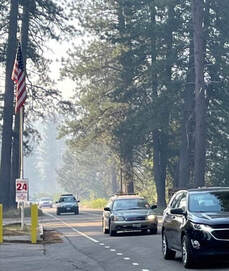
Wawona Road (Hwy 41) Open to OUTBOUND (southbound) Traffic
7/22 4:12 PM Wawona Road (Hwy 41) is open to OUTBOUND (southbound) traffic from Yosemite Valley to South Entrance (toward Oakhurst).
This early opening is a result of the closure on Highway at Midpines due to the Oak fire.
Wawona Road will fully open (to two-way traffic) between South Entrance and Yosemite West (and on to Yosemite Valley) on July 23 at 6 am.
7/22 4:12 PM Wawona Road (Hwy 41) is open to OUTBOUND (southbound) traffic from Yosemite Valley to South Entrance (toward Oakhurst).
This early opening is a result of the closure on Highway at Midpines due to the Oak fire.
Wawona Road will fully open (to two-way traffic) between South Entrance and Yosemite West (and on to Yosemite Valley) on July 23 at 6 am.
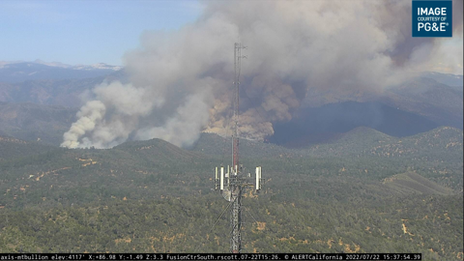
New Fire Near Midpines
Watch Duty- Jul 22nd at 3:38 PM
The fire is now 150 acres w/ critical rate of spread & is established in the canyon. 2 additional large air tankers requested
Watch Duty- Jul 22nd at 3:38 PM
The fire is now 150 acres w/ critical rate of spread & is established in the canyon. 2 additional large air tankers requested
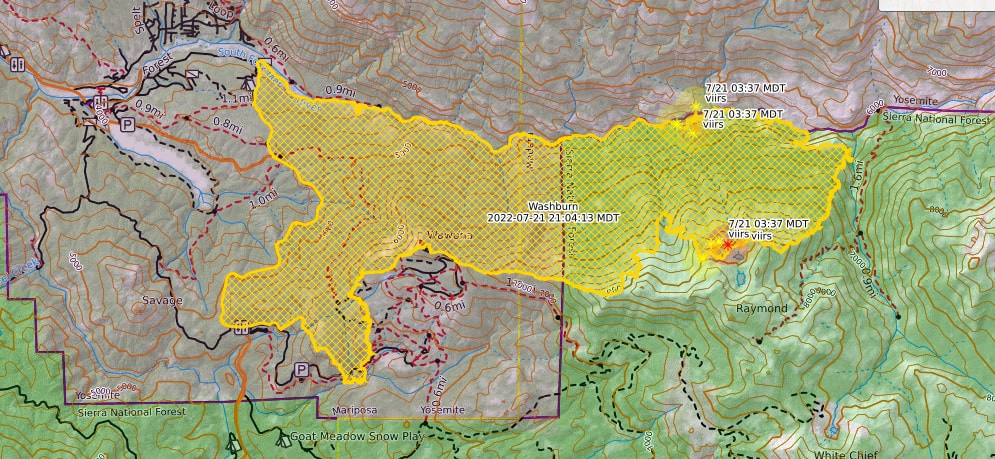
Washburn Fire 79% Contained
InciWeb 7/22
The fire remains within containment lines, no fire spread was observed. A very persistent warm and dry weather continues to support pockets of minor interior active fire behavior, that includes smoldering, creeping, and an occasional flare-up in unburned fuels. Diurnal wind flow will continue to provide diminishing smoke accumulation in the valleys during the night under a strong inversion, while southwest winds at higher elevations retain a relatively clear sky.
InciWeb 7/22
The fire remains within containment lines, no fire spread was observed. A very persistent warm and dry weather continues to support pockets of minor interior active fire behavior, that includes smoldering, creeping, and an occasional flare-up in unburned fuels. Diurnal wind flow will continue to provide diminishing smoke accumulation in the valleys during the night under a strong inversion, while southwest winds at higher elevations retain a relatively clear sky.
